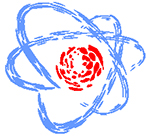Speaker
Dr
Mikołaj Oettingen
(AGH University of Science and Technology)
Description
The reactor-grade plutonium existing in spent nuclear fuel as well as stocked weapon-grade plutonium may be treated as a significant source of energy, if properly burned in dedicated nuclear reactors. In addition, incineration of plutonium in combination with fertile thorium is profitable from the non-proliferation point of view because the secondary plutonium is not formed and produced fissile U233 is contaminated with easily traceable U232. The CANDU reactors can operate in flexible fuel-cycle because of good neutron economy, possibility of on-power refueling and simple fuel bundle design. Hence, they may serve as burners of global plutonium stockpiles, especially if mixed with thorium. The paper presents application of The Monte Carlo Continuous Energy Burn-up Code - MCB to the numerical modeling of the CANDU-6 reactor fuel channel. The three-dimensional numerical model consists of twelve fuel bundles and theirs surroundings. Each fuel bundle was divided in two fuel zones – the inner zone composed of seven rods and outer zone composed of 30 rods. The content of fissile and fertile material in zones was varied in order to achieve different neutronic characteristics i.e. burnup, criticality, spent fuel composition and activity. The system was irradiated on average power of 5.4 MWth. Finally, the comparative analysis between different fuel vectors was performed and hints for further calculations were shown. The supercomputer PROMETHEUS available at the Academic Computer Center Cyfronet of the AGH University, Krakow, Poland was applied for all numerical simulations.
Author
Dr
Mikołaj Oettingen
(AGH University of Science and Technology)

